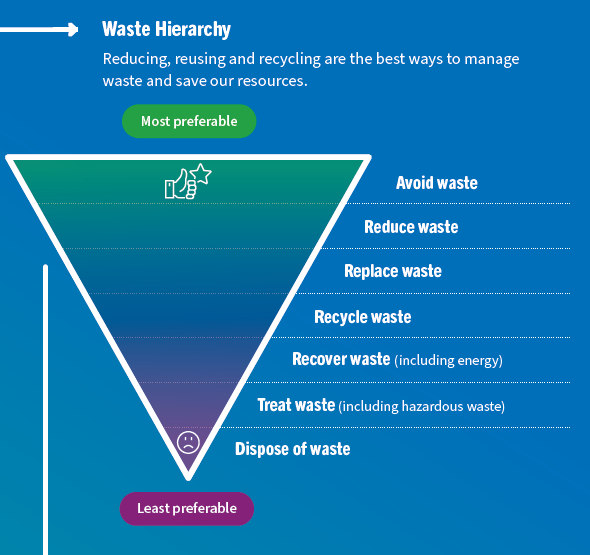Recycling at home
There are many simple ways to reduce the waste you create and keep more out of landfill. By making smarter choices about what you buy, reusing what you can, and sorting your waste into the right bins, you can make a real difference and reduce your impact on the environment.
Our kerbside recycling bins make it easy to recycle many household items. However, it’s important to know what belongs in the recycling bin and what doesn’t. The wrong items - like plastic bags, food waste, and e-waste - can contaminate our recycling stream, making it harder to recycle properly.
Useful tools to help you recycle right at home:
- Recycling bin sticker - Download here or collect yours from the City of Darwin Civic Centre.
- Recycling in Darwin flyer - Learn more about how to recycle and where your recycling goes in Darwin. Download here.
- A-Z Recycling Guide - Find out how to dispose of different items responsibly in Darwin with our simple A - Z Recycling Guide.
- What items can go in the yellow recycling bin?
-
These items can go in the recycling bin – Loose, not in plastic bags!
- Glass bottles and jars
- Cardboard, magazines, paper and cartons
- Aluminium and steel cans, trays and foil
- All hard plastic containers
- What items can’t go in the yellow recycling bin?
-
Don’t put these items in the recycling bin:
- Plastic bags and other soft plastics
- Small plastic lids
- Food and garden waste (compost at home)
- E-waste and cables (drop at local recycling stations)
- Sheet glass and mirrors
- Old bedding and clothing
- Kitchenware and ceramics (donate at local charity shops)
- Building waste and hosing
- Nappies
- Styrofoam
- Takeaway coffee cups and lids
- Compostable packaging
- Batteries (drop at local recycling stations)
While these items can’t go in your yellow recycling bin, some can still be recycled in other ways! You can donate reusable items, compost food waste at home, take blister packs to your local pharmacy, and drop-off e-waste, green waste and more to Shoal Bay Waste Management Facility. Another big way to reduce your waste is to bring your own cup, container and cutlery for takeaway food & drink. Check out our A-Z Recycling Guide for more!
- How much waste does the average Australian household produces in a year?
-
The average Australian household produces a busload of waste every year. In Darwin, around 82% of that waste goes to landfill in red general waste bins. City of Darwin is committed to reducing the amount of waste going to landfill to 50% by 2031, and helping residents to recycle right is key to this goal.
- What happens to the contents of your yellow bin?
-
The contents of your yellow bin are taken to Darwin’s own Materials Recovery Facility in Berrimah (affectionately known as ‘the merf’).
At ‘the merf’, items are sorted by hand and put through specialised machinery to separate them by material type. The separated plastics, metals, paper and cardboard are then baled up to be sent away for recycling into something new.
- How to Safely Dispose of EPIRBs (Emergency Position Indicating Radio Beacons) and Flares
-
Proper disposal of expired EPIRBs and flares is essential for both our boating community and the environment. These items contain hazardous materials and should never be placed in your red bin. Instead, they can be dropped off at the NT Water Police in East Arm (27 Nebo Rd, East Arm NT 0822) during office hours for safe deactivation and disposal. Incorrect disposal may trigger false emergency alerts or even cause fires at waste facilities, endangering lives and resources. By disposing of these items correctly, we help protect the environment and support emergency services.
- What is the Waste Hierarchy and why does it matter?
-
The Waste Hierarchy is a guide to help prioritise how we use, reuse and dispose of material for the best environmental outcome now and into the future.
Put simply, the higher up the hierarchy you act, the better for the environment.
Avoid – Avoid producing waste in the first place. For example, before buying something, ask yourself ‘Do I really need it?’
Reduce – Reduce the amount of waste created. For example, choose reusable products and those with less packaging
Re-use – Use things more than once, buy second-hand and donate unwanted items that could be reused. Recycle – The items placed in your recycling bin are separated into their raw materials and sent away for recycling into something new.
Recover – Industry can generate energy from waste. For example, landfill gas is captured at Shoal Bay Waste Management Facility and turned into renewable energy.
Dispose – As a last resort, dispose of waste in landfill.

Recycling programs
- Recycle for Good
- Recycling in Darwin - In collaboration with NT Recycling Solutions
- Waste Education in Darwin
-
City of Darwin opened its Education Centre at Shoal Bay Waste Management Facility in 2024. The Education Centre provides an opportunity for the community to learn about waste management and resource recovery in Darwin.
City of Darwin also supports the COOLmob Darwin program that offers waste education lessons and resources to local schools, as well as other sustainability resources to both schools and the broader Darwin community.
